Epson EB 450Wi, EB-440W, EB-460I User Manual
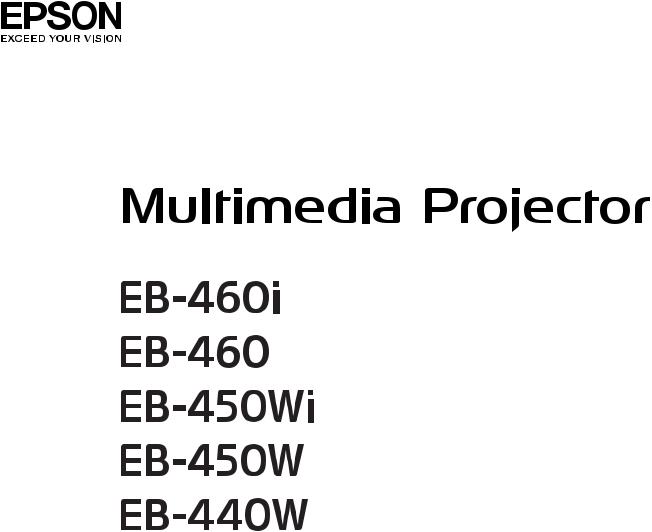
User’s Guide

Notations Used in This Guide
•Safety indications
The documentation and the projector use graphical symbols to show how to use the projector safely. Please understand and respect these caution symbols in order to avoid injury to persons or property.
|
|
Warning |
This symbol indicates information that, if ignored, could possibly result in personal injury or even death due to incorrect handling. |
|
|
|
|
|
|
|
|
Caution |
This symbol indicates information that, if ignored, could possibly result in personal injury or physical damage due to incorrect handling. |
|
|
|
|
|
|
• General information indications |
|
|||
|
|
|
|
|
|
|
Attention |
Indicates procedures which may result in damage or injury if sufficient care is not taken. |
|
|
|
|
|
|
|
|
q |
Indicates additional information and points which may be useful to know regarding a topic. |
|
|
|
|
|
|
|
|
|
|
|
|
|
s |
Indicates a page where detailed information regarding a topic can be found. |
|
|
|
|
|
|
|
|
g |
Indicates that an explanation of the underlined word or words in front of this symbol appears in the glossary of terms. See the "Glossary" |
|
|
|
|
|
section of the "Appendix". s p.131 |
|
|
|
|
|
|
|
|
|
Indicates operating methods and the order of operations. |
|
|
Procedure |
|
|
|
|
|
|
The procedure indicated should be carried out in the order of the numbered steps. |
|
|
[(Name)] |
Indicates the name of the buttons on the Remote Control or the Control panel. |
|
|
|
|
|
Example: [Esc] button |
|
|
|
||
|
"(Menu Name)" |
Indicates Configuration Menu items. |
||
|
|
Brightness |
Example: |
|
|
|
|
|
Select "Brightness" from the Image menu. |
|
|
|
|
Image menu - Brightness |
|
|
|
|
|

Contents |
|
3 |
|
|
|
Notations Used in This Guide . . . . . . . . . . . . . . . . . . . . . . . . 2
Introduction
Projector Features . . . . . . . . . . . . . . . . . . . . . . . . . . . . . . . . . . . . . . . . . . 7
Convenient Equipment Designed for Ease of Use . . . . . . . . . . . . . . . . . . . . . . . . . 7 Easy to handle . . . . . . . . . . . . . . . . . . . . . . . . . . . . . . . . . . . . . . . . . . . . . . 7 Enhanced security functions . . . . . . . . . . . . . . . . . . . . . . . . . . . . . . . . . . . . . 7 Controlling Computer on Projection Surface (EB-460i/450Wi Only) . . . . . . . . . . . . . 8 Easy Interactive Function . . . . . . . . . . . . . . . . . . . . . . . . . . . . . . . . . . . . . . . 8 Drawing function . . . . . . . . . . . . . . . . . . . . . . . . . . . . . . . . . . . . . . . . . . . . 8 Selecting Various Input Sources with Multi-Connection . . . . . . . . . . . . . . . . . . . . 8 Taking full advantage of a network connection . . . . . . . . . . . . . . . . . . . . . . . . 8 Connecting with a USB cable and projecting (USB Display) . . . . . . . . . . . . . . . . 9
Projecting a computer screen with the optional Quick Wireless Connection USB
Key . . . . . . . . . . . . . . . . . . . . . . . . . . . . . . . . . . . . . . . . . . . . . . . . . . . . . . 9 Projecting JPEG images without connecting a computer . . . . . . . . . . . . . . . . . 10 Enlarge and project your files with the Document Camera . . . . . . . . . . . . . . . . 10
Part Names and Functions . . . . . . . . . . . . . . . . . . . . . . . . . . . . . . . . . . 11
Front/Top . . . . . . . . . . . . . . . . . . . . . . . . . . . . . . . . . . . . . . . . . . . . . . . . . . . 11 Sides . . . . . . . . . . . . . . . . . . . . . . . . . . . . . . . . . . . . . . . . . . . . . . . . . . . . . . 12 Interfaces . . . . . . . . . . . . . . . . . . . . . . . . . . . . . . . . . . . . . . . . . . . . . . . . . . . 13 Base (with Slide Plate) . . . . . . . . . . . . . . . . . . . . . . . . . . . . . . . . . . . . . . . . . . 14 Base (without Slide Plate) . . . . . . . . . . . . . . . . . . . . . . . . . . . . . . . . . . . . . . . . 15 Control panel . . . . . . . . . . . . . . . . . . . . . . . . . . . . . . . . . . . . . . . . . . . . . . . . 15 Remote Control . . . . . . . . . . . . . . . . . . . . . . . . . . . . . . . . . . . . . . . . . . . . . . . 16 Easy Interactive Pen(EB-460i/450Wi Only) . . . . . . . . . . . . . . . . . . . . . . . . . . . . . 18
Various Ways to Use the Projector
Changing the Installation Mode . . . . . . . . . . . . . . . . . . . . . . . . . . . . . 20
Changing the Projected Image . . . . . . . . . . . . . . . . . . . . . . . . . . . . . . 21
Automatically Detect Input Signal and Change the Projected Image (Source Search)
. . . . . . . . . . . . . . . . . . . . . . . . . . . . . . . . . . . . . . . . . . . . . . . . . . . . . . . . . . 21
Switch to the target image by Remote Control . . . . . . . . . . . . . . . . . . . . . . . . . . 22
Connecting with a USB Cable and Projecting (USB Display) . . . . 23
System Requirements . . . . . . . . . . . . . . . . . . . . . . . . . . . . . . . . . . . . . . . . . . 23
Connecting . . . . . . . . . . . . . . . . . . . . . . . . . . . . . . . . . . . . . . . . . . . . . . . . . 24
Connecting for the first time . . . . . . . . . . . . . . . . . . . . . . . . . . . . . . . . . . . . 24
From the second time . . . . . . . . . . . . . . . . . . . . . . . . . . . . . . . . . . . . . . . . 27
Presentations Using Slideshow . . . . . . . . . . . . . . . . . . . . . . . . . . . . . 28
Files that can be Projected Using Slideshow . . . . . . . . . . . . . . . . . . . . . . . . . . . 28 Specifications for files that can be projected using Slideshow . . . . . . . . . . . . . . 28 Slideshow usage examples . . . . . . . . . . . . . . . . . . . . . . . . . . . . . . . . . . . . . 28 Slideshow Basic Operations . . . . . . . . . . . . . . . . . . . . . . . . . . . . . . . . . . . . . . 29 Starting and closing Slideshow . . . . . . . . . . . . . . . . . . . . . . . . . . . . . . . . . . 29 Slideshow basic operations . . . . . . . . . . . . . . . . . . . . . . . . . . . . . . . . . . . . . 29 Rotating images . . . . . . . . . . . . . . . . . . . . . . . . . . . . . . . . . . . . . . . . . . . . 30 Projecting Image Files . . . . . . . . . . . . . . . . . . . . . . . . . . . . . . . . . . . . . . . . . . 31 Projecting images . . . . . . . . . . . . . . . . . . . . . . . . . . . . . . . . . . . . . . . . . . . 31 Projecting all image files in a folder in sequence (Slideshow) . . . . . . . . . . . . . . 32 Image File Display Settings and Slideshow Operation Settings . . . . . . . . . . . . . . . 33
Connecting External Equipment . . . . . . . . . . . . . . . . . . . . . . . . . . . . 34
Connecting and Removing USB Devices . . . . . . . . . . . . . . . . . . . . . . . . . . . . . . 34 Connecting USB devices . . . . . . . . . . . . . . . . . . . . . . . . . . . . . . . . . . . . . . . 34 Removing USB devices . . . . . . . . . . . . . . . . . . . . . . . . . . . . . . . . . . . . . . . . 34 Connecting an External Monitor . . . . . . . . . . . . . . . . . . . . . . . . . . . . . . . . . . . 35 Connecting External Speakers . . . . . . . . . . . . . . . . . . . . . . . . . . . . . . . . . . . . . 36 Connecting a microphone . . . . . . . . . . . . . . . . . . . . . . . . . . . . . . . . . . . . . . . 36
Connecting a LAN Cable . . . . . . . . . . . . . . . . . . . . . . . . . . . . . . . . . . . . 37 Installing the Wireless LAN Unit . . . . . . . . . . . . . . . . . . . . . . . . . . . . . 38 Functions for Enhancing Projection . . . . . . . . . . . . . . . . . . . . . . . . . 39
Selecting the Projection Quality (Selecting Color Mode) . . . . . . . . . . . . . . . . . . . 39 Setting the Auto Iris . . . . . . . . . . . . . . . . . . . . . . . . . . . . . . . . . . . . . . . . . . . . 40 Hiding the Image and Sound Temporarily (A/V Mute) . . . . . . . . . . . . . . . . . . . . . 40 Freezing the Image (Freeze) . . . . . . . . . . . . . . . . . . . . . . . . . . . . . . . . . . . . . . 41 Changing the Aspect Ratio . . . . . . . . . . . . . . . . . . . . . . . . . . . . . . . . . . . . . . . 41

Contents |
|
4 |
|
|
|
Changing methods . . . . . . . . . . . . . . . . . . . . . . . . . . . . . . . . . . . . . . . . . . 41 Changing the aspect ratio for video equipment images . . . . . . . . . . . . . . . . . . 42 Changing the aspect ratio for computer images (EB-460i/460) . . . . . . . . . . . . . 43 Changing the aspect ratio for computer images (EB-450Wi/450W/440W) . . . . . . 44 Using the Pointer to Highlight Sections (Pointer) . . . . . . . . . . . . . . . . . . . . . . . . 46 Enlarging Part of the Image (E-Zoom) . . . . . . . . . . . . . . . . . . . . . . . . . . . . . . . . 47 Operating the Mouse Pointer by Remote Control (Wireless Mouse) . . . . . . . . . . . . 48
Security Functions . . . . . . . . . . . . . . . . . . . . . . . . . . . . . . . . . . . . . . . . . 50
Managing Users (Password Protect) . . . . . . . . . . . . . . . . . . . . . . . . . . . . . . . . . 50 Type of Password Protect . . . . . . . . . . . . . . . . . . . . . . . . . . . . . . . . . . . . . . 50 Setting Password Protect . . . . . . . . . . . . . . . . . . . . . . . . . . . . . . . . . . . . . . 50 Entering the Password . . . . . . . . . . . . . . . . . . . . . . . . . . . . . . . . . . . . . . . . 51 Restricting Operation (Control Panel Lock) . . . . . . . . . . . . . . . . . . . . . . . . . . . . 52 Anti-Theft Lock . . . . . . . . . . . . . . . . . . . . . . . . . . . . . . . . . . . . . . . . . . . . . . . 53 Installing the wire lock . . . . . . . . . . . . . . . . . . . . . . . . . . . . . . . . . . . . . . . . 53
Easy Interactive Function (EB-460i/450Wi only) . . . . . . . . . . . . . . 54
Summary of Easy Interactive Function . . . . . . . . . . . . . . . . . . . . . . . . . . . . . . . 54 Operation Steps . . . . . . . . . . . . . . . . . . . . . . . . . . . . . . . . . . . . . . . . . . . . . . 55 Using Easy Interactive Function for the first time . . . . . . . . . . . . . . . . . . . . . . 55 From the second time . . . . . . . . . . . . . . . . . . . . . . . . . . . . . . . . . . . . . . . . 55 System Requirements . . . . . . . . . . . . . . . . . . . . . . . . . . . . . . . . . . . . . . . . . . 55 Using Easy Interactive Function for the First Time . . . . . . . . . . . . . . . . . . . . . . . . 56 Using Easy Interactive Function from the Second Time . . . . . . . . . . . . . . . . . . . . 59 Calibration . . . . . . . . . . . . . . . . . . . . . . . . . . . . . . . . . . . . . . . . . . . . . . . . . . 61 Cases in which calibration is required . . . . . . . . . . . . . . . . . . . . . . . . . . . . . . 61 Replacing the Batteries for the Easy Interactive Pen . . . . . . . . . . . . . . . . . . . . . . 61
Changing Settings Using a Web Browser (Web Control) . . . . . . . 63
Displaying Web Control . . . . . . . . . . . . . . . . . . . . . . . . . . . . . . . . . . . . . . . . . 63 Entering the IP address of the projector . . . . . . . . . . . . . . . . . . . . . . . . . . . . 63 Displaying Web Remote . . . . . . . . . . . . . . . . . . . . . . . . . . . . . . . . . . . . . . . . . 64
Using the Mail Notification Function to Report Problems . . . . . . 66 Management Using SNMP . . . . . . . . . . . . . . . . . . . . . . . . . . . . . . . . . . 67 Saving a User's Logo . . . . . . . . . . . . . . . . . . . . . . . . . . . . . . . . . . . . . . . 68 Saving User Pattern . . . . . . . . . . . . . . . . . . . . . . . . . . . . . . . . . . . . . . . . 70
Configuration Menu
Using the Configuration Menu . . . . . . . . . . . . . . . . . . . . . . . . . . . . . . 73
List of Functions . . . . . . . . . . . . . . . . . . . . . . . . . . . . . . . . . . . . . . . . . . . 74
Image Menu . . . . . . . . . . . . . . . . . . . . . . . . . . . . . . . . . . . . . . . . . . . . . . . . . |
74 |
Signal Menu . . . . . . . . . . . . . . . . . . . . . . . . . . . . . . . . . . . . . . . . . . . . . . . . . |
75 |
Settings Menu . . . . . . . . . . . . . . . . . . . . . . . . . . . . . . . . . . . . . . . . . . . . . . . . |
76 |
Extended Menu . . . . . . . . . . . . . . . . . . . . . . . . . . . . . . . . . . . . . . . . . . . . . . . |
78 |
Network Menu . . . . . . . . . . . . . . . . . . . . . . . . . . . . . . . . . . . . . . . . . . . . . . . |
80 |
Notes on using the Network menu . . . . . . . . . . . . . . . . . . . . . . . . . . . . . . . . |
81 |
Soft keyboard operations . . . . . . . . . . . . . . . . . . . . . . . . . . . . . . . . . . . . . . |
81 |
Basic Menu . . . . . . . . . . . . . . . . . . . . . . . . . . . . . . . . . . . . . . . . . . . . . . . . |
82 |
Wireless LAN Menu . . . . . . . . . . . . . . . . . . . . . . . . . . . . . . . . . . . . . . . . . . |
83 |
Security menu . . . . . . . . . . . . . . . . . . . . . . . . . . . . . . . . . . . . . . . . . . . . . . |
84 |
When WEP is selected . . . . . . . . . . . . . . . . . . . . . . . . . . . . . . . . . . . . . . . . |
85 |
When WPA-PSK (TKIP) or WPA2-PSK (AES) is selected . . . . . . . . . . . . . . . . . . . |
85 |
Wired LAN menu . . . . . . . . . . . . . . . . . . . . . . . . . . . . . . . . . . . . . . . . . . . . |
86 |
Mail menu . . . . . . . . . . . . . . . . . . . . . . . . . . . . . . . . . . . . . . . . . . . . . . . . |
87 |
Others Menu . . . . . . . . . . . . . . . . . . . . . . . . . . . . . . . . . . . . . . . . . . . . . . . |
88 |
Reset Menu . . . . . . . . . . . . . . . . . . . . . . . . . . . . . . . . . . . . . . . . . . . . . . . |
89 |
Info Menu (Display Only) . . . . . . . . . . . . . . . . . . . . . . . . . . . . . . . . . . . . . . . . |
90 |
Reset Menu . . . . . . . . . . . . . . . . . . . . . . . . . . . . . . . . . . . . . . . . . . . . . . . . . |
91 |

Contents |
|
5 |
|
|
|
Troubleshooting
Using the Help . . . . . . . . . . . . . . . . . . . . . . . . . . . . . . . . . . . . . . . . . . . . . 93
Problem Solving . . . . . . . . . . . . . . . . . . . . . . . . . . . . . . . . . . . . . . . . . . . 94
Reading the Indicators . . . . . . . . . . . . . . . . . . . . . . . . . . . . . . . . . . . . . . . . . . 94 t indicator is lit or flashing red . . . . . . . . . . . . . . . . . . . . . . . . . . . . . . . . . . 95 m o indicator is flashing or lit orange . . . . . . . . . . . . . . . . . . . . . . . . . . . . . . 96 When the Indicators Provide No Help . . . . . . . . . . . . . . . . . . . . . . . . . . . . . . . . 97 Problems relating to images . . . . . . . . . . . . . . . . . . . . . . . . . . . . . . . . . . . . 98 Problems when projection starts . . . . . . . . . . . . . . . . . . . . . . . . . . . . . . . . 102 Problems relating to monitoring and control . . . . . . . . . . . . . . . . . . . . . . . . 102 Problems relating to Easy Interactive Function . . . . . . . . . . . . . . . . . . . . . . . 103 Other problems . . . . . . . . . . . . . . . . . . . . . . . . . . . . . . . . . . . . . . . . . . . . 104
Reading Error Notification Mail . . . . . . . . . . . . . . . . . . . . . . . . . . . . 106
Appendix
Cleaning Parts . . . . . . . . . . . . . . . . . . . . . . . . . . . . . . . . . . . . . . . . . . . . 108
Cleaning the Projector's Surface . . . . . . . . . . . . . . . . . . . . . . . . . . . . . . . . . . . 108 Cleaning the Projection Window . . . . . . . . . . . . . . . . . . . . . . . . . . . . . . . . . . 108 Cleaning the Air Filter . . . . . . . . . . . . . . . . . . . . . . . . . . . . . . . . . . . . . . . . . . 108
Replacing Consumables . . . . . . . . . . . . . . . . . . . . . . . . . . . . . . . . . . . 110
Replacing the Remote Control Batteries . . . . . . . . . . . . . . . . . . . . . . . . . . . . . 110 Replacing the Lamp . . . . . . . . . . . . . . . . . . . . . . . . . . . . . . . . . . . . . . . . . . . 111 Lamp replacement period . . . . . . . . . . . . . . . . . . . . . . . . . . . . . . . . . . . . . 111 How to replace the Lamp . . . . . . . . . . . . . . . . . . . . . . . . . . . . . . . . . . . . . 111 Resetting the Lamp Hours . . . . . . . . . . . . . . . . . . . . . . . . . . . . . . . . . . . . . 114 Replacing the Air Filter . . . . . . . . . . . . . . . . . . . . . . . . . . . . . . . . . . . . . . . . . 114 Air filter replacement period . . . . . . . . . . . . . . . . . . . . . . . . . . . . . . . . . . . 114 How to replace the air filter . . . . . . . . . . . . . . . . . . . . . . . . . . . . . . . . . . . . 114
Optional Accessories and Consumables . . . . . . . . . . . . . . . . . . . . 116
Screen Size and Projection Distance . . . . . . . . . . . . . . . . . . . . . . . . 117
Projection Distance (EB-460i/460) . . . . . . . . . . . . . . . . . . . . . . . . . . . . . . . . . . |
117 |
Projection Distance (EB-450Wi/450W/440W) . . . . . . . . . . . . . . . . . . . . . . . . . . |
117 |
List of Supported Resolutions . . . . . . . . . . . . . . . . . . . . . . . . . . . . . 119
Supported Monitor Displays (EB-460i/460) . . . . . . . . . . . . . . . . . . . . . . . . . . . . 119
Computer signals (analog RGB) . . . . . . . . . . . . . . . . . . . . . . . . . . . . . . . . . 119
Component Video . . . . . . . . . . . . . . . . . . . . . . . . . . . . . . . . . . . . . . . . . . 119
Composite Video/S-Video . . . . . . . . . . . . . . . . . . . . . . . . . . . . . . . . . . . . . 119
Supported Monitor Displays (EB-450Wi/450W/440W) . . . . . . . . . . . . . . . . . . . . 119
Computer signals (analog RGB) . . . . . . . . . . . . . . . . . . . . . . . . . . . . . . . . . 119
Component Video . . . . . . . . . . . . . . . . . . . . . . . . . . . . . . . . . . . . . . . . . . 120
Composite Video/S-Video . . . . . . . . . . . . . . . . . . . . . . . . . . . . . . . . . . . . . 120
ESC/VP21 Commands . . . . . . . . . . . . . . . . . . . . . . . . . . . . . . . . . . . . . 121
Command List . . . . . . . . . . . . . . . . . . . . . . . . . . . . . . . . . . . . . . . . . . . . . . . |
121 |
Cable Layouts . . . . . . . . . . . . . . . . . . . . . . . . . . . . . . . . . . . . . . . . . . . . . . . |
122 |
Serial Connection . . . . . . . . . . . . . . . . . . . . . . . . . . . . . . . . . . . . . . . . . . |
122 |
Communications protocol . . . . . . . . . . . . . . . . . . . . . . . . . . . . . . . . . . . . . |
122 |
About PJLink . . . . . . . . . . . . . . . . . . . . . . . . . . . . . . . . . . . . . . . . . . . . . 123
Specifications . . . . . . . . . . . . . . . . . . . . . . . . . . . . . . . . . . . . . . . . . . . . 124
Projector General Specifications . . . . . . . . . . . . . . . . . . . . . . . . . . . . . . . . . . . |
124 |
Appearance . . . . . . . . . . . . . . . . . . . . . . . . . . . . . . . . . . . . . . . . . . . . . . 129
Glossary . . . . . . . . . . . . . . . . . . . . . . . . . . . . . . . . . . . . . . . . . . . . . . . . . 131
General Notes . . . . . . . . . . . . . . . . . . . . . . . . . . . . . . . . . . . . . . . . . . . . 133
Wireless Telegraphy Act Regulations . . . . . . . . . . . . . . . . . . . . . . . . . . . . . . . 133
About Notations . . . . . . . . . . . . . . . . . . . . . . . . . . . . . . . . . . . . . . . . . . . . . 133
General Notice . . . . . . . . . . . . . . . . . . . . . . . . . . . . . . . . . . . . . . . . . . . . . . 133
Index . . . . . . . . . . . . . . . . . . . . . . . . . . . . . . . . . . . . . . . . . . . . . . . . . . . . 151
Optional accessories . . . . . . . . . . . . . . . . . . . . . . . . . . . . . . . . . . . . . . . . . . 116 Consumables . . . . . . . . . . . . . . . . . . . . . . . . . . . . . . . . . . . . . . . . . . . . . . . 116

Introduction
This chapter explains the projector's features and the part names.

Projector Features |
|
7 |
|
|
|
Convenient Equipment Designed for Ease of Use
Easy to handle
•Easy wall mounting
The projector is supplied with a dedicated slide plate that makes troublesome wall mounting easy.
The slide plate is integrated into the projector main unit, so mounting is easy and installation time has been reduced compared to previous models. s Installation Guide
You can also perform maintenance such as replacing the air filter and lamp simply while projector is mounted to a wall.
•No special screen required
Installation in a wide range of places is possible because you can project images onto a projection surface such as a wall if there is no projector screen.
•Short distance projection
At 47 cm, the recommended shortest projection distance allows you to place the projector close to the screen. s p.117
If you mount the projector to a wall and project images from diagonally above, you can give your presentation without the shadow of anybody
who stands up near the projection surface appearing in the images. Furthermore, when your back is facing the screen, the projector light does not dazzle you because it does not interfere with your field of view.
•Direct power on/off
In places where power is managed centrally, such as in a conference
room, you can set the projector to turn on or off when the main power source to which the projector is connected is switched on or off.
•Display of projection lines on the projection surface
The pattern function for projecting ruled lines or a grid enables effective use of the projection surface in lessons and presentations.
•Speaker
The incorporation of a high-output 10 W speaker enables your voice to reach the edges of the room even in spacious classrooms.
•Projection screen for WXGA (EB-450Wi/450W/440W only)
With a computer that has a 16:10 WXGA wide LCD display, the image can be projected in the same aspect. This allows you to effectively use the width of whiteboards and other landscape-oriented projection surfaces.
•Control the projector from a computer
You can use the Web Control function and Web Remote function to perform the same operations on a computer as with the projector's control panel or remote control. s p.63
Enhanced security functions
•Password Protect to restrict and manage users
By setting a Password you can restrict who can use the projector. s p.50
•Control Panel Lock restricts button operation on the Control panel
You can use this to prevent people changing projector settings without permission at events, in schools, and so on. s p.52
•Equipped with anti-theft security devices
The projector is equipped with the following types of anti-theft security functions. s p.53
•Security slot
•Security cable installation point

Projector Features |
|
8 |
|
|
|
Controlling Computer on Projection Surface (EB-460i/450Wi Only)
Easy Interactive Function
By simply connecting a computer to the projector, you can control the computer on the projection screen and give an effective, interactive presentation or lesson. s p.54
Drawing function
You can use a graphics application to import text and diagrams have been hand-drawn on the projection surface with an electronic pen (Easy Interactive Pen). This combines the functions of a whiteboard and screen without the need for either. s p.54
Selecting Various Input Sources with MultiConnection
As well as connecting a computer cable, you can select various interfaces such as a USB cable, USB memory, or LAN connection. This allows you to select from a range of input sources to match your usage environment.
Taking full advantage of a network connection
You can make effective use of your network by using the supplied "EPSON Projector Software for Meeting & Monitoring" to perform efficient and varied presentations and meetings. s EasyMP Network Projection Operation Guide
•Connect a Computer to the projector via a network
You can project by connecting to an already constructed network system. You can hold efficient meetings by projecting from multiple computers connected to a network system without having to change any cables.
•Connecting wirelessly to a computer
When you install the optional wireless LAN unit in the projector, you can connect wirelessly to a computer. s p.38
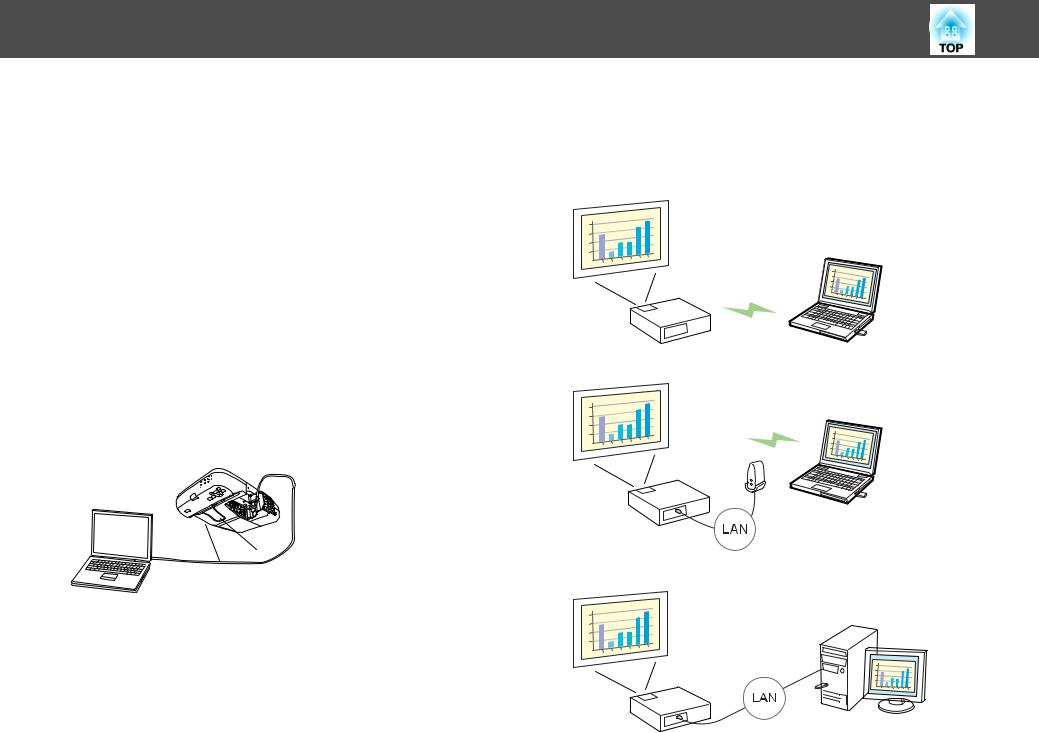
Projector Features
•Connection method for various networks
The following methods are available for connecting the projector to a network. Select whichever method suites your environment. s EasyMP Network Projection Operation Guide
•Advanced Connection Mode
Advanced Connection Mode is an infrastructure connection, offering you a method of connecting to an already constructed network.
•Quick Connection Mode
Quick Connection Mode is a connection method that can only be executed when the optional wireless LAN unit is installed.
Quick Connection Mode temporarily allocates the projector's SSID to the computer and makes an ad-hoc connection, and then restores the comput er's network settings after disconnecting.
Connecting with a USB cable and projecting (USB Display)
By simply connecting the supplied USB cable to a computer, you can project images from the computer's screen.
s Quick Start Guide , p.23
Projecting a computer screen with the optional Quick Wireless Connection USB Key
Using the optional Quick Wireless Connection USB Key, you can quickly connect a computer to the projector for projection.
9
With the Quick Wireless Connection USB Key, you can connect to a projector on a network even if EasyMP Network Projection is not installed.
For example, you can connect under the following environments.
•Connect in Quick Connection Mode using the optional Wireless LAN unit.
• Connect to the network via an access point.
• Connect to the network via a wired LAN connection.

Projector Features |
|
10 |
|
|
|
s p.116
q |
• This projector is not compatible with the Network Projector |
function which is a standard feature in Windows Vista and |
|
|
Windows 7. |
|
• Limitations when projecting from Windows Media Center |
|
When Windows Media Center is in full-screen mode, images cannot |
|
be projected. Switch to the window display mode to project the |
|
images. |
|
|
Projecting JPEG images without connecting a computer
You can project a slideshow of JPEG images saved on a USB device such as a USB compatible digital camera, hard disk, or USB memory by simply connecting to the projector. s p.28
Enlarge and project your files with the Document Camera
A USB compatible Document Camera is available as an optional extra. With this Document Camera there is no need for a power cable. You can connect easily with one USB cable, and its clean design really simplifies projecting and enlarging your documents. s p.34

Part Names and Functions |
|
11 |
|
|
|
Front/Top
Name |
Function |
A Remote Receiver |
Receives signals from the remote control. |
|
s Quick Start Guide |
|
|
B Lamp cover |
Open this cover when replacing the projector's Lamp. |
|
s p.111 |
CLamp Cover Fixing Screw to fix the Lamp cover in place. s p.111
Screw
D Air exhaust vent |
Exhaust vent for air used to cool the projector internally. |
 Caution
Caution
Do not place anything that can become warped or damaged by heat near the air exhaust vents, or bring your hands or face close to the vents while pro jection is in progress.
|
Name |
Function |
E |
Cable cover fixing |
Screws to fix the cable cover in place. |
|
screws |
s Quick Start Guide |
|
|
|
F |
Cable cover |
When connecting to an input port, loosen the two screws |
|
|
and open this cover. |
|
|
s Quick Start Guide |
|
|
|
G |
Control panel |
Allows you to operate and check the status of the |
|
|
projector. s p.15 |
|
|
|
H |
Speaker |
Outputs audio for images currently being projected or |
|
|
audio from the Microphone (Mic) input port. |
|
|
|
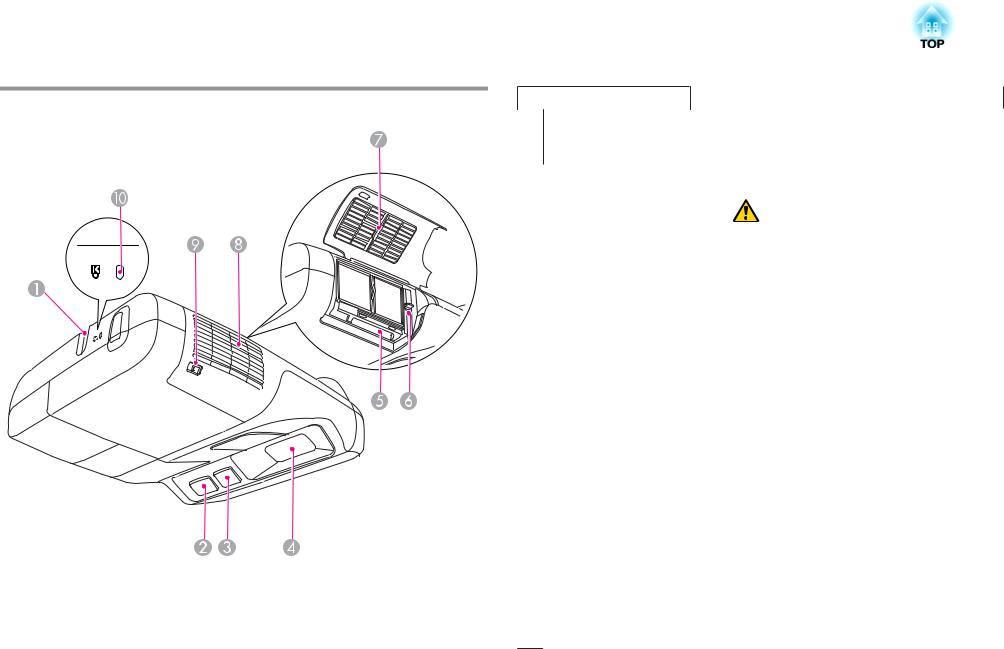
Part Names and Functions |
|
12 |
|
|
|
Sides
|
Name |
Function |
A |
Security cable |
Pass a commercially available wire lock through here and |
|
installation point |
lock it in place. s p.53 |
|
|
|
B |
Remote Receiver |
Receives signals from the remote control. |
|
|
s Quick Start Guide |
|
|
|
Name |
Function |
C Easy Interactive |
Receives signals from the Easy Interactive Pen. |
Function receiver |
s p.54 |
(EB-460i/450Wi only) |
|
|
|
D Projection window |
Projects images. |
|
|
Warning |
|
|
|
• Do not look at this during projection. |
|
|
|
• Do not place objects on or hand nears this. Doing |
|
|
|
so is dangerous because the focus of projection |
|
|
|
light results in high temperatures. |
|
|
|
|
|
|
|
|
|
E Wireless LAN unit |
Insert the optional wireless LAN unit. s p.38 |
|
|
insertion slot |
|
|
|
|
|
|
|
F Focus lever |
Adjusts the image focus. |
|
|
|
Opens the air filter cover and operates the focus lever. |
|
|
|
s Quick Start Guide |
|
|
|
|
|
|
G Air filter cover |
Open this cover when replacing the air filter or installing |
|
|
|
the optional Wireless LAN unit. |
|
|
|
|
|
|
H Air intake vent |
Takes in air to cool the projector internally. If dust collects |
|
|
(Air filter) |
here it can cause the internal temperature to rise, and this |
|
|
|
can lead to problems with operation and shorten the |
|
|
|
optical engine's service life. Be sure to clean the Air filter |
|
|
|
regularly. s p.108, p.114 |
|
|
|
|
|
|
I Air filter cover |
Opens and closes the air filter cover. s p.114 |
|
|
open/close lever |
Open this cover when installing the optional Wireless |
|
|
|
LAN unit. s p.38 |
|
|
|
|
|
|
J Security slot |
The Security slot is compatible with the Microsaver |
|
|
|
Security System manufactured by Kensington. |
|
|
|
s p.53 |
|
|
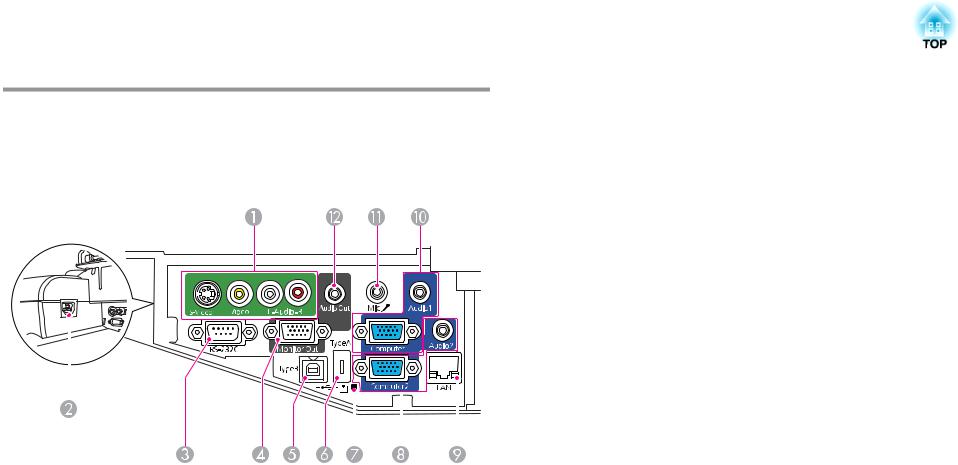
Part Names and Functions |
|
13 |
|
|
|
Interfaces
Remove the cable cover to view the following ports.
Remove the cable cover to connect equipment.
s Quick Start Guide
|
|
|
|
|
|
|
|
|
|
|
|
|
|
|
|
|
|
|
|
|
|
|
|
|
|
|
|
|
|
|
|
|
|
|
|
|
|
|
|
|
|
|
|
|
|
|
|
|
|
|
|
|
|
|
|
|
|
|
|
|
|
|
|
|
|
|
|
|
|
|
|
|
|
Name |
Function |
|||||
A |
S-Video input port |
For S-video signals from video sources. |
||||||
|
Video input port |
For composite video signals from video sources. |
||||||
|
Audio-L/R input port |
Connects to the audio output port to output audio from |
||||||
|
equipment connected to the S-Video input port or the |
|||||||
|
|
|
||||||
|
|
|
Video input port. |
|||||
|
|
|
s Quick Start Guide |
|||||
|
|
|
||||||
B |
Power inlet |
Connects to the power cable. |
||||||
|
|
|
s Quick Start Guide |
|||||
|
|
|
|
|
|
|
|
|
|
Name |
Function |
C |
RS-232C port |
When controlling the projector from a computer, connect |
|
|
it to the computer with an RS-232C cable. This port is for |
|
|
control use and should not normally be used. s p.122 |
|
|
|
D |
Monitor Output |
Outputs the image signals from the computer connected |
|
(Monitor Out) port |
to the Computer1 input port to an external monitor. This |
|
|
is not available for component video signals or other |
|
|
signals being input to any port other than the Computer1 |
|
|
input port. s p.35 |
|
|
|
E |
USB(TypeB) port |
Connects the projector to a computer via the supplied USB |
|
|
cable to project images from the computer. |
|
|
s p.23 |
|
|
Also use this port to connect to a computer via the |
|
|
supplied USB cable to use the wireless mouse function. |
|
|
s p.48 |
|
|
Also use this port to connect to a computer via the |
|
|
supplied USB cable to use the Easy Interactive Function. |
|
|
(EB-460i/450Wi only) s p.54 |
|
|
|
F |
USB(TypeA) port |
Projects a JPEG image Slideshow when memories or |
|
|
digital cameras are connected to the USB compatible port. |
|
|
s p.28 |
|
|
Also connects to the optional Document Camera. |
|
|
|
G |
USB indicator |
Notifies you of the status of the USB device connected to |
|
|
the USB(TypeA) port as described below. |
|
|
OFF: USB device is not connected |
|
|
Orange Light ON: USB device is connected |
|
|
Green Light ON: USB device is operating |
|
|
Red Light ON: Error |
|
|
|
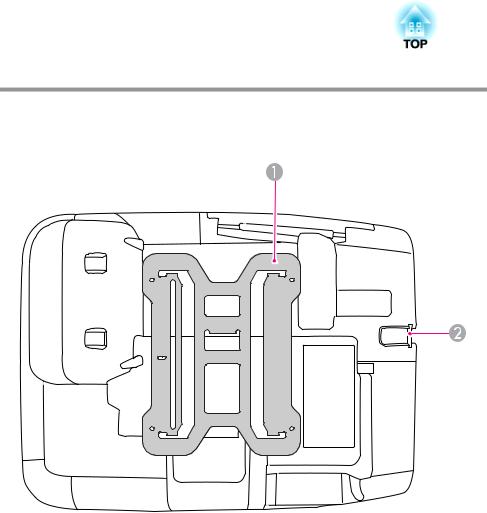
Part Names and Functions |
|
14 |
|
|
|
|
Name |
Function |
H |
Computer2 input port |
Inputs image signals from a computer and component |
|
Audio2 port |
video signals from other video sources. |
|
|
|
|
|
Connects to the audio output port of equipment |
|
|
connected to the Computer2 input port to input audio. |
|
|
Also, when the input source is one of the following and you |
|
|
want to output audio from the projector, connect the |
|
|
audio source to theAudio2 port. |
|
|
- USB: When playing back a slideshow from a USB storage |
|
|
device connected to the USB(TypeA) port, or when |
|
|
projecting from the optional Document Camera |
|
|
- USB Display |
|
|
- LAN |
|
|
s Quick Start Guide |
|
|
|
I |
LAN port |
Connects to a LAN cable and then to a network. |
|
|
s p.37 |
|
|
|
J |
Computer1 input port |
Inputs image signals from a computer and component |
|
Audio1 port |
video signals from other video sources. |
|
|
|
|
|
Connects to the audio output port of equipment |
|
|
connected to the Computer1 input port to input audio. |
|
|
s Quick Start Guide |
|
|
|
K |
Microphone (Mic) |
Connects to a microphone. s p.36 |
|
input port |
|
|
|
|
L |
Audio Output (Audio |
Outputs the audio of the images currently being projected |
|
Out) port |
or the audio input from the Microphone (Mic) input port |
|
|
to an external speaker. s p.36 |
|
|
|
Base (with Slide Plate)
A slide plate is attached to the projector main unit at the time of shipment.
|
Name |
Function |
A |
Slide plate |
Connect this to the setting plate when mounting the |
|
|
projector on a wall. s Installation Guide |
|
|
|
B |
Security cable |
Pass a commercially available wire lock through here and |
|
installation point |
lock it in place. s p.53 |
|
|
|
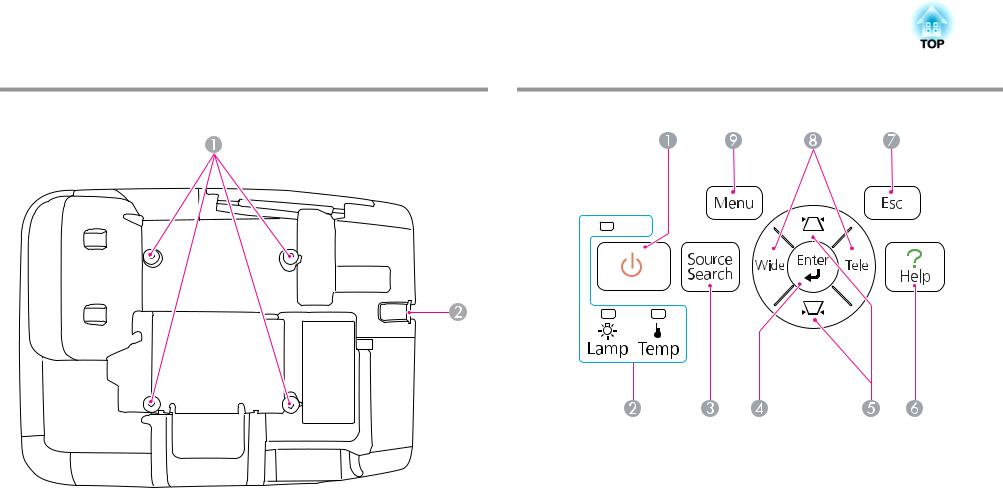
Part Names and Functions |
|
15 |
|
|
|
Base (without Slide Plate) |
Control panel |
|
Name |
Function |
A |
Ceiling mount fixing |
Connect the ceiling mount fixing points to a commercially |
|
points |
available ceiling mount or wall mount when mounting the |
|
(four points) |
projector to a ceiling or wall. For details, see the |
|
|
documentation supplied with the the ceiling mount or |
|
|
wall mount. |
B |
Security cable |
Pass a commercially available wire lock through here and |
|
installation point |
lock it in place. s p.53 |
|
|
|
|
Name |
Function |
A |
[t] button |
Turns the projector power on or off. |
|
|
s Quick Start Guide |
|
|
|
B |
Status indicators |
The color of the indicators and whether they are flashing |
|
|
or lit indicate the status of the projector. s p.94 |
|
|
|
C |
[Source Search] |
Changes to the next input source that is connected to the |
|
button |
projector and is sending an image. s p.21 |
|
|
|
D |
[Enter] button |
If pressed during projection of a computer image signal, it |
|
|
automatically adjusts the Tracking-Sync., and Position to |
|
|
project the optimum image. |
|
|
When the Configuration Menu or Help screen is |
|
|
displayed, pressing this button confirms the current item |
|
|
and moves to the next level. s p.73 |
|
|
|
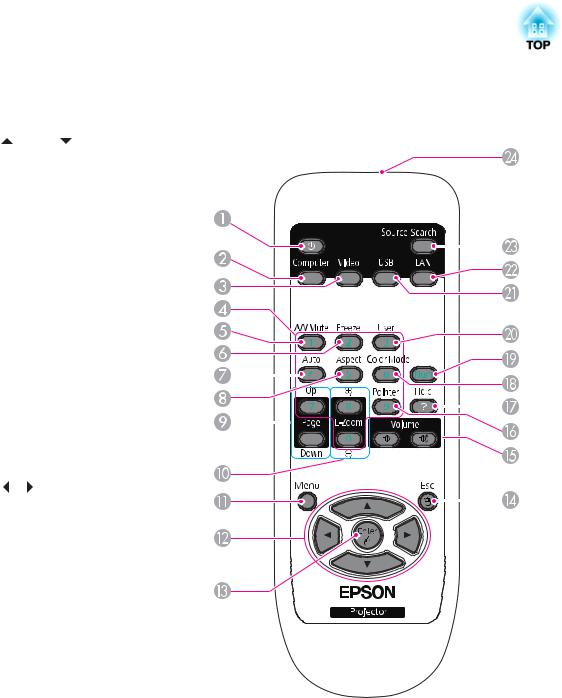
Part Names and Functions |
|
16 |
|
|
|
|
Name |
Function |
|
|
|
|
|
|
|
|
|
|
|
|
|
|
Remote Control |
||||||||||
E |
[w][v] buttons |
Corrects Keystone distortion. In the following cases, |
|
||||||||||
|
|
|
|
|
|
|
|
|
|
||||
|
|
however, these buttons function as the [ |
] and [ |
] |
|
|
|
|
|
|
|
|
|
|
|
buttons. |
|
|
|
|
|
|
|
|
|
|
|
|
|
– When the projected image is being sent through a |
|
|
|
|
|
|
|
|
|
|
|
|
|
Network connection |
|
|
|
|
|
|
|
|
|
|
|
|
|
– When the Slideshow function is being used for |
|
|
|
|
|
|
|
|
|
|
|
|
|
projection |
|
|
|
|
|
|
|
|
|
|
|
|
|
If pressed when a Configuration Menu or Help screen is |
|
|
|
|
|
|
|
|
|
||
|
|
|
|
|
|
|
|
|
|
|
|||
|
|
displayed, these buttons selects menu items and setting |
|
|
|
|
|
|
|
|
|
||
|
|
values. |
|
|
|
|
|
|
|
|
|
|
|
|
|
s Quick Start Guide , p.73 |
|
|
|
|
|
|
|
|
|
|
|
|
|
|
|
|
|
|
|
|
|
|
|
||
F |
[Help] button |
Displays and closes the Help screen which shows you how |
|
|
|
|
|
|
|
|
|
||
|
|
to deal with problems if they occur. s p.93 |
|
|
|
|
|
|
|
|
|
|
|
|
|
|
|
|
|
|
|
|
|
|
|
|
|
G |
[Esc] button |
Stops the current function. |
|
|
|
|
|
|
|
|
|
|
|
|
|
|
|
|
|
|
|
|
|
|
|||
|
|
|
|
|
|
|
|
|
|
|
|||
|
|
When the Configuration Menu is displayed, pressing this |
|
|
|
|
|
|
|
|
|
||
|
|
|
|
|
|
|
|
|
|
|
|||
|
|
button moves to the previous menu level. s p.73 |
|
|
|
|
|
|
|
|
|
|
|
|
|
|
|
|
|
|
|
|
|
|
|
||
H |
[Wide][Tele] button |
Adjusts Tele/Wide. Press the [Tele] button to reduce the |
|
|
|
|
|
|
|
|
|
||
|
|
|
|
|
|
|
|
|
|||||
|
|
size of the projection screen and press the [Wide] button |
|
|
|
|
|
|
|
|
|
||
|
|
to increase the size of the projection screen. |
|
|
|
|
|
|
|
|
|
|
|
|
|
When the Configuration Menu or Help screen is |
|
|
|
|
|
|
|
|
|
|
|
|
|
displayed, these buttons function as the [ |
][ ] buttons, |
|
|
|
|
|
|
|
|
|
|
|
|
which select menu items and setting values. |
|
|
|
|
|
|
|
|
|
|
|
|
|
|
|
|
|
|
|
|
|
|
|
||
|
|
s Quick Start Guide |
|
|
|
|
|
|
|
|
|
|
|
|
|
|
|
|
|
|
|
|
|
|
|
|
|
I |
[Menu] button |
Displays and closes the Configuration Menu. |
|
|
|
|
|
|
|
|
|
|
|
|
|
s p.73 |
|
|
|
|
|
|
|
|
|
|
|
|
|
|
|
|
|
|
|
|
|
|
|
|
|
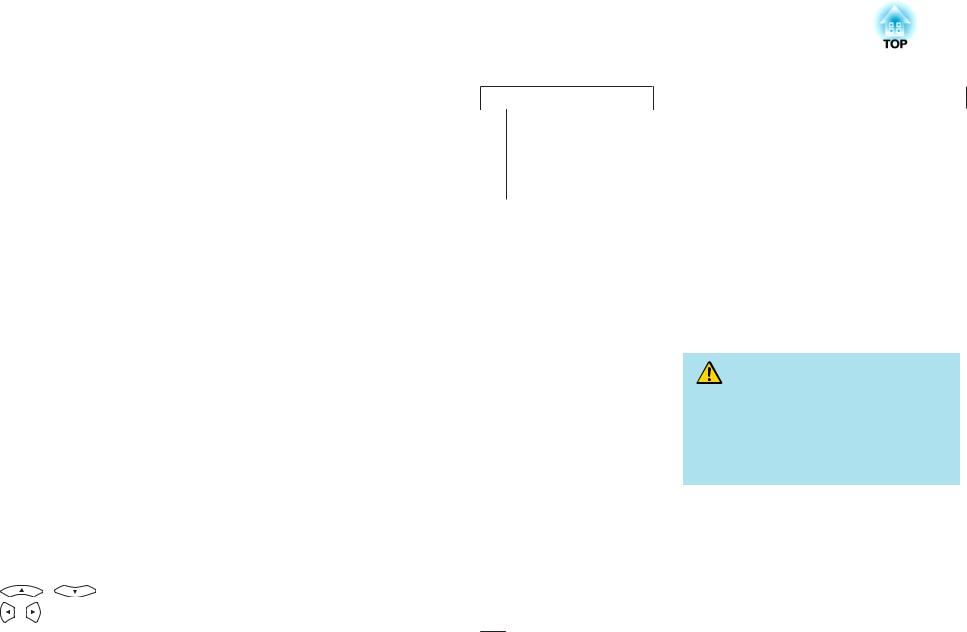
Part Names and Functions |
|
17 |
|
|
|
|
|
Name |
|
Function |
A |
[t] button |
|
Turns the projector power on or off. |
|
|
|
|
|
s Quick Start Guide |
|
|
|
||
B |
[Computer] button |
Each time you press the button, input changes between |
||
|
|
|
|
images from the Computer1 input port and the |
|
|
|
|
Computer2 input port. s p.22 |
|
|
|
|
|
C |
[Video] button |
|
Each time you press the button, input changes between |
|
|
|
|
|
images from the Video input port and the S-Video input |
|
|
|
|
port. s p.22 |
|
|
|
|
|
D |
Numeric buttons |
|
Use when entering a password. s p.50 |
|
|
|
|
||
E |
[A/V Mute] button |
Turns the video and audio on or off. s p.40 |
||
|
|
|
|
|
F |
[Freeze] button |
|
Images are paused or unpaused. s p.41 |
|
|
|
|
|
|
G |
[Auto] button |
|
If pressed during projection of a computer image signal, it |
|
|
|
|
|
automatically adjusts the Tracking-Sync., and Position to |
|
|
|
|
project the optimum image. |
|
|
|
|
|
H |
[Aspect] button |
|
The Aspect Ratio changes each time the button is pressed. |
|
|
|
|
|
s p.41 |
|
|
|
|
|
I |
[Page] buttons |
|
When you are using the Wireless Mouse function, USB |
|
|
([Up]) ([Down]) |
|
Display function, or the input source is projecting a file of |
|
|
|
|
|
application software that supports page up/down via the |
|
|
|
|
LAN, you can move the page up and down by pressing |
|
|
|
|
these buttons. s p.48 |
|
|
|
||
J |
[E-Zoom] buttons |
Enlarges or reduces the image without changing the |
||
|
(z)(x) |
|
projection size. s p.47 |
|
|
|
|
|
|
K |
[Menu] button |
|
Displays and closes the Configuration Menu. s p.73 |
|
|
|
|
|
|
L |
[ |
][ |
] |
When the Configuration Menu or Help screen is |
|
[ ][ |
] buttons |
|
displayed, pressing these buttons selects menu items and |
|
|
setting values. s p.73, p.93 |
||
|
|
|
|
|
|
|
|
|
During Wireless Mouse function, the mouse pointer |
|
|
|
|
moves in the direction the button is pushed. s p.48 |
|
|
|
|
|
Name |
Function |
M [Enter] button |
When the Configuration Menu or Help screen is |
|
displayed, pressing this button confirms the current item |
|
and moves to the next level. s p.73, p.93 |
|
Acts as a mouse's left button when using the Wireless |
|
Mouse function. s p.48 |
|
|
N [Esc] button |
Stops the current function. If pressed when the |
|
Configuration Menu is displayed, it moves to the previous |
|
level. s p.73, p.93 |
|
Acts as a mouse's right button when using the Wireless |
|
Mouse function. s p.48 |
|
|
O [Volume] buttons (a) |
(a) Decreases the Volume. |
(b) |
(b) Increases the Volume. |
|
s Quick Start Guide |
|
|
Caution |
|
|
|
Do not start when the volume is set too high. |
|
|
|
A sudden excessive volume may cause loss of hear |
|
|
|
ing. Always lower the volume before turning the |
|
|
|
power off, and gradually increase the volume after |
|
|
|
turning the power on. |
|
|
|
|
|
|
|
|
|
P [Pointer] button |
Press this button to activate the on-screen pointer. |
|
|
|
s p.46 |
|
|
|
|
|
|
Q [Help] button |
Displays and closes the Help screen which shows you how |
|
|
|
to deal with problems if they occur. s p.93 |
|
|
|
|
|
|
R [Color Mode] button |
Each time the button is pressed, the Color Mode changes. |
|
|
|
s p.39 |
|
|
|
|
|
|
S [Num] button |
Use when entering a Password. s p.50 |
|
|
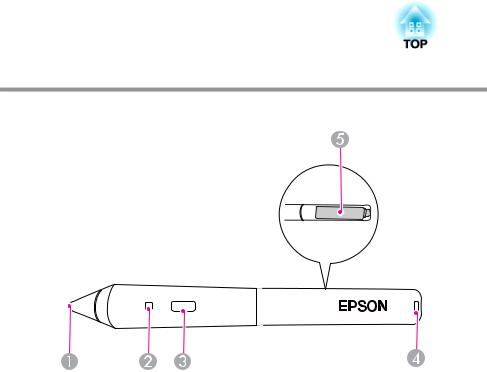
Part Names and Functions |
|
18 |
|
|
|
|
Name |
Function |
T |
[User] button |
Select any frequently used item from the five available |
|
|
Configuration Menu items, and assign it to this button. By |
|
|
pressing the button the assigned menu item selection/ |
|
|
adjustment screen is displayed, allowing you to make one- |
|
|
touch settings/adjustments. s p.76 |
|
|
The menu Power Consumption is assigned as the default |
|
|
setting. |
|
|
|
U |
[USB] button |
Each time you press the button, input changes between |
|
|
images from the equipment connected to USB Display |
|
|
and USB(TypeA) port. s p.22 |
|
|
|
V |
[LAN] button |
Changes to the images projected with EasyMP Network |
|
|
Projection. When you are projecting via Quick Wireless |
|
|
Connection using the optional Quick Wireless |
|
|
Connection USB Key, pressing this button changes to that |
|
|
image. s p.22 |
|
|
|
W |
[Search] button |
Changes to the next input source that is connected to the |
|
|
projector and is sending an image. s p.21 |
|
|
|
X |
Remote control light- |
Outputs remote control signals. |
|
emitting area |
|
|
|
|
Easy Interactive Pen(EB-460i/450Wi Only)
|
Name |
Function |
A |
Pen tip switch |
Functions as the left button of a mouse. |
|
|
|
B |
Battery indicator |
When you press the button, this indicator lights green if |
|
|
there is any remaining battery power. |
|
|
It does not light if there is not much remaining battery |
|
|
power. If this happens, replace the batteries. s p.61 |
|
|
|
C |
Button |
Functions as the right button of a mouse. |
|
|
|
D |
Strap attachment hole |
You can attach a commercially available strap. |
|
|
|
E |
Battery cover |
Open this cover when replacing the batteries. s p.61 |
|
|
|

Various Ways to Use the Projector
This chapter explains useful functions for giving presentations, connecting external equipment, and security functions.
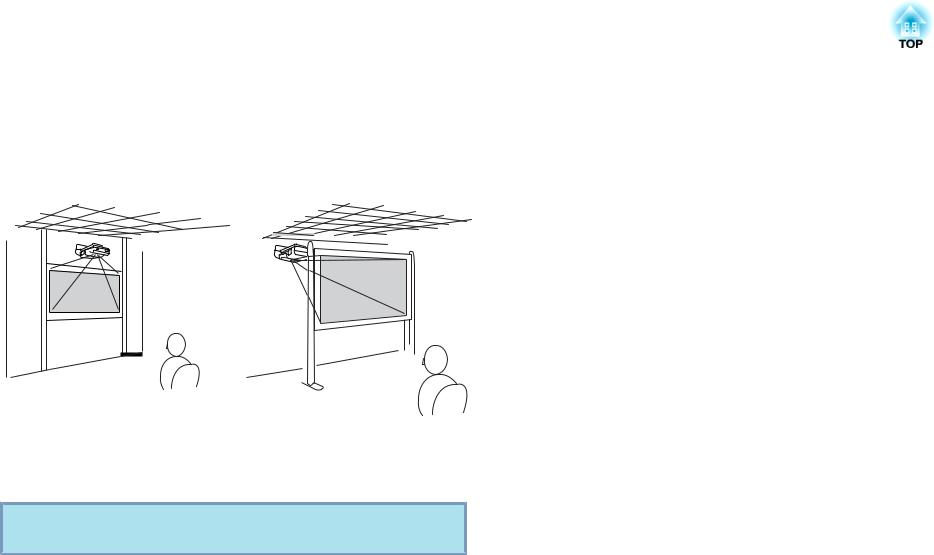
Changing the Installation Mode |
|
20 |
|
|
|
The projector supports the following two different projection methods. Install according to the conditions of the installation location.
•Suspend the projector from the ceiling and project images from in front of the screen. (Front/ Ceiling projection)
•Suspend the projector from the ceiling and project images from behind a translucent screen.
(Rear/Ceiling projection)
At the time of shipment, the projector is set to be installed suspended from a ceiling and to project images from the front of the screen (Front/Ceiling).
q Set either Front/Ceiling or Rear/Ceiling setting from the Configuration Menu. s p.78
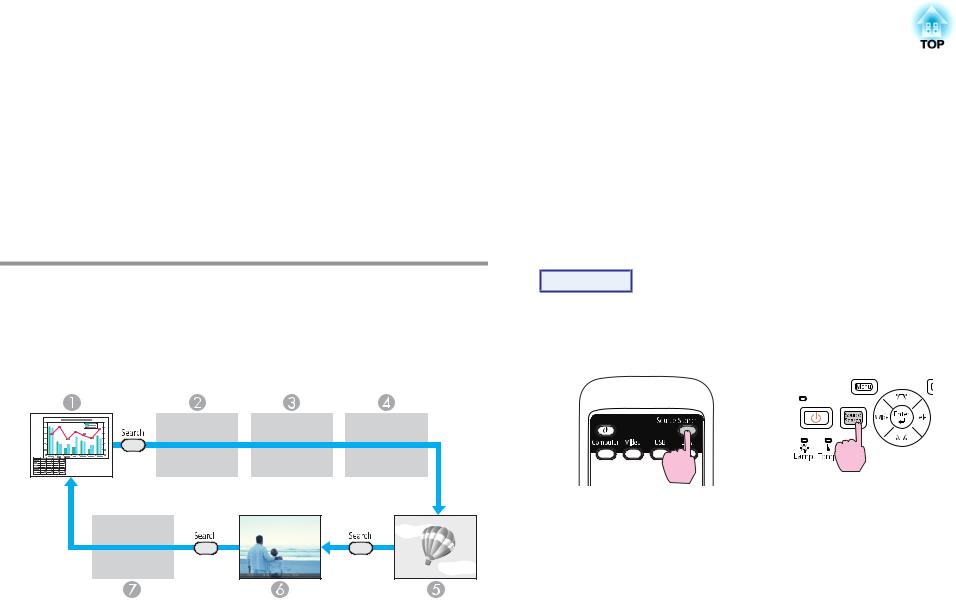
Changing the Projected Image |
|
21 |
|
|
|
You can change the projected image in the following two ways.
•Changing by Source Search
The projector automatically detects signals being input from connected equipment, and the image being input from the equipment is projected.
•Changes to the target image.
You can use the Remote Control buttons to change to the target input port.
Automatically Detect Input Signal and Change the Projected Image (Source Search)
You can project the target image quickly as input ports with no image signal being input are ignored when you change by pressing the [Source Search] button.
AComputer1
BComputer2
CS-Video
DVideo
EUSB Display
FUSB*: When the image is from a device connected to the USB(TypeA) port.
GLAN: When the projector is connected to a computer via a network, and images from EasyMP Network Projection are projected.
Skipped when no image signal is being input.
*USB input source indicates that a Slideshow is being played back from a USB storage device connected to the USB(TypeA) port, or that images are being projected from the optional Document Camera.
Procedure
When your video equipment is connected, start playback before beginning this operation.
Using the Remote Control |
Using the Control panel |
When two or more pieces of equipment are connected, press the [Source Search] button until the target image is projected.
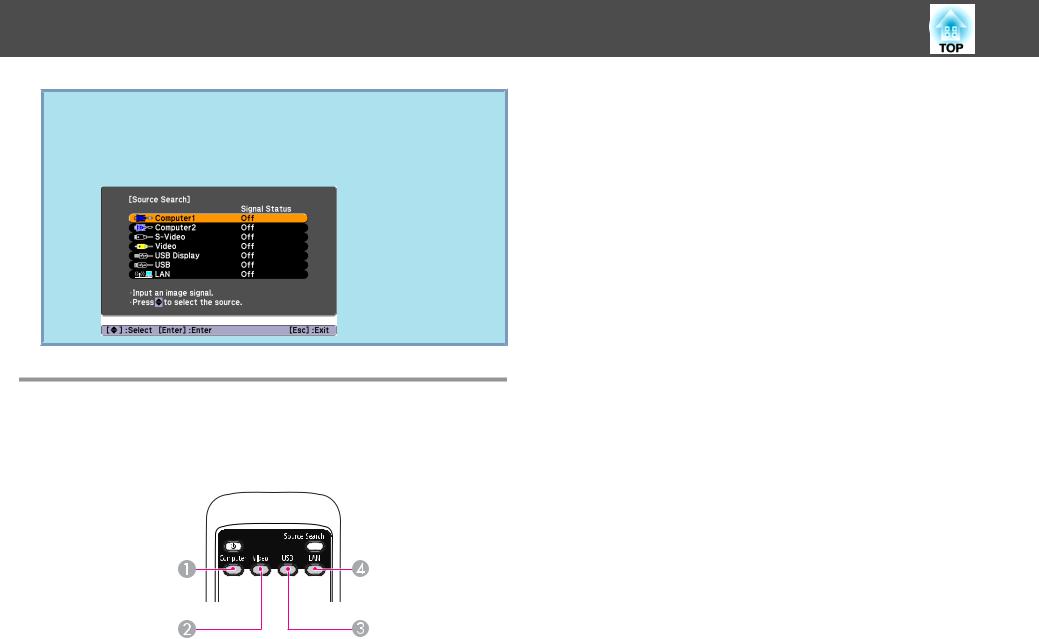
Changing the Projected Image
q The following screen showing the status of image signals is displayed when only the image that the projector is currently displaying is available, or when no image signal can be found. You can select the input port where the equipment you want to use is connected. If no operation is performed after about 10 seconds, the screen closes.
Switch to the target image by Remote Control
You can change directly to the target image by pressing the following buttons on the Remote Control.
Remote Control
AEach time you press the button, input changes between images from the Computer1 input port and the Computer2 input port.
BEach time you press the button, input changes between images from the Video input port and the S-Video input port.
22
CEach time you press the button, input changes between images from the equipment connected to USB Display and USB(TypeA) port.
DChanges to the images projected with EasyMP Network Projection. When you are projecting via Quick Wireless Connection using the optional Quick Wireless Connection USB Key, this button changes to that image.

Connecting with a USB Cable and Projecting (USB Display) |
|
23 |
|
|
|
You can use the supplied USB cable to connect the projector to a computer to project images from the computer. This function is called USB Display. Simply by connecting via a USB cable, images from the computer can be displayed.
To activate the USB Display function, set USB Type B to USB Display from the Extended menu in the Configuration Menu.
The following shows the default settings for USB Type B.
•EB-460i/450Wi: Off
•EB-460/450W/440W: USB Display
For EB-460i/450Wi, the setting needs to be changed in advance. s p.78
System Requirements
For Windows
OS |
Windows 2000 Service Pack 4 |
|
Windows XP |
|
Windows XP Service Pack 2 or later |
|
Windows Vista |
|
Windows Vista Service Pack 1 or later |
|
Windows 7 |
|
|
CPU |
Mobile Pentium III 1.2GHz or faster |
|
Recommended: Pentium M 1.6GHz or faster |
|
|
Amount of |
256MB or more |
Memory |
Recommended: 512MB or more |
|
|
Hard Disk |
20MB or more |
Free Space |
|
|
|
Display |
Resolution of no |
lower |
than |
640x480 and no higher than |
|
1600x1200. |
|
|
|
|
Display color of |
16-bit |
color |
or greater |
|
|
|
|
|
Only 32-bit versions are supported.
For Mac OS
OS |
Mac OS X 10.5.1 or later |
|
Mac OS X 10.6.x |
|
|
CPU |
Power PC G4 1GHz or faster |
|
Recommended: Intel Core Duo 1.83GHz or faster |
|
|
Amount of |
512MB or more |
Memory |
|
|
|
Hard Disk |
20MB or more |
Free space |
|
|
|
Display |
Resolution of no lower than 640x480 and no higher than |
|
1680x1200. |
|
Display color of 16-bit color or greater |
|
|
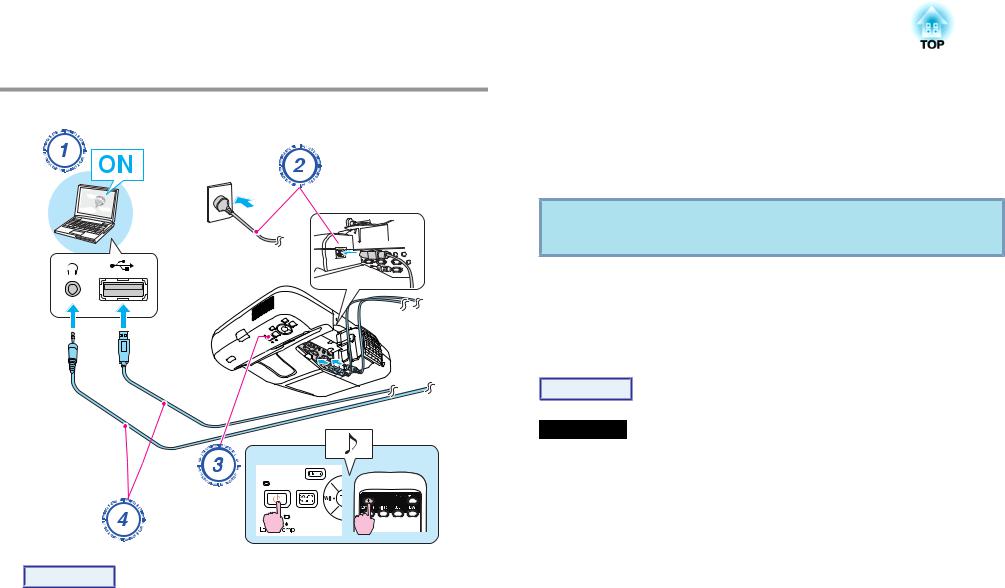
Connecting with a USB Cable and Projecting (USB Display) |
|
24 |
|
|
|
Connecting
Procedure
A Turn the computer on.
B Connect to the power cable (supplied).
C Turn the projector on.
D Connect to the USB cable.
When outputting audio from the projector's speaker, connect an audio cable (commercially available) to the Audio2 port.
s "Connecting for the first time" p.24
s "From the second time" p.27
Attention
Connect the projector directly to the computer and not via a USB hub.
Connecting for the first time
The first time you connect, the driver needs to be installed. The procedure is different for Windows and Mac OS.
Procedure
For Windows
A Driver installation starts automatically.
When you are using Windows 2000, double-click My Computer -
EPSON_PJ_UD - EMP_UDSE.exe on your computer.
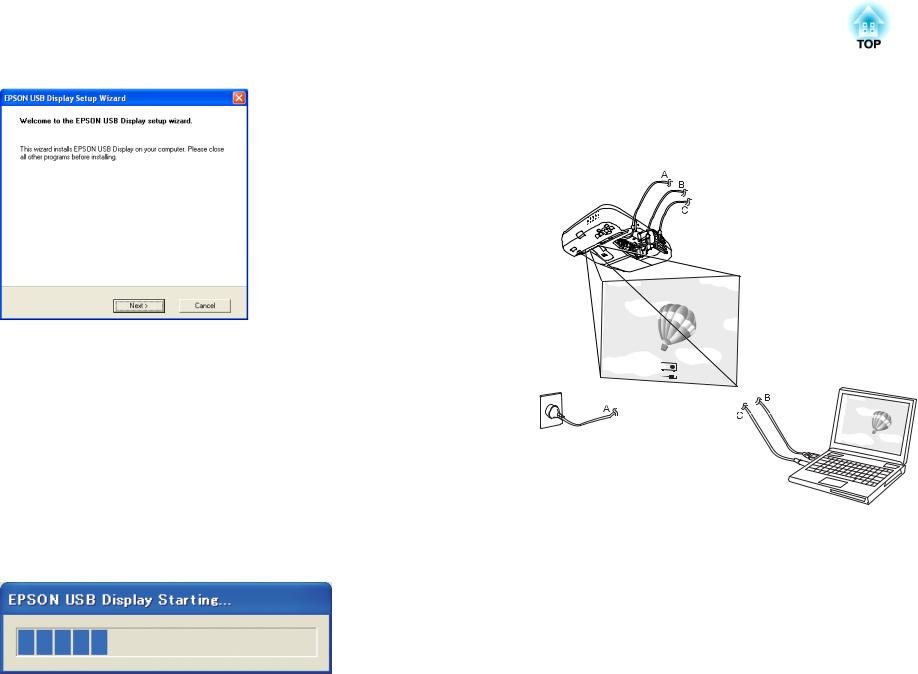
Connecting with a USB Cable and Projecting (USB Display) |
|
25 |
|
|
|
C Computer images are projected.
It may take a while before computer images are projected. Until computer images are projected, leave the equipment as it is and do not disconnect the USB cable or turn off the power to the projector.
When using a computer running Windows 2000 under user authority, a Windows error message is displayed during installation and you may not be able to install the software. In this case, try updating Windows to the latest version, restart, and then try to connect again.
For more details, contact the nearest address provided in the Support and Service Guide. s Epson Projector Contact List
B When the License Agreement screen is displayed, click
"Agree".
If the driver is not installed, you cannot start USB Display. Select
Agree to install the driver. If you want to cancel installation, click
Disagree.
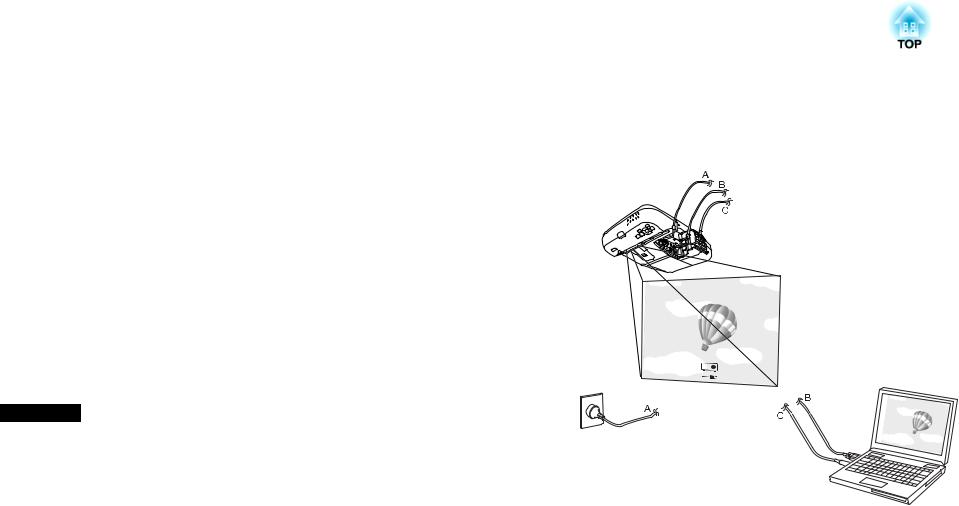
Connecting with a USB Cable and Projecting (USB Display) |
|
26 |
|
|
|
q |
• If it is not installed automatically, double-click My Computer - |
EPSON_PJ_UD - EMP_UDSE.EXE, on your computer. |
|
|
• If nothing is projected for some reason, click All Programs - |
|
EPSON Projector - EPSON USB Display - EPSON USB Display |
|
Vx.x on your computer. |
|
• If the mouse pointer flickers on the computer screen, click All |
|
Programs - EPSON Projector - EPSON USB Display - EPSONUSB |
|
DisplayVx.x on your computer, and then clear the Transfer layered |
|
window checkbox. |
|
• To uninstall the driver, open Control Panel - Add/Remove |
|
Programs - and uninstall EPSON USB Display Vx.x. |
|
• Disconnecting |
|
The projector can be disconnected simply by disconnecting the USB |
|
cable. There is no need to use the Safely Remove Hardware feature |
|
in Windows. |
|
|
When connecting next time, see s "From the second time" p.27.
For Mac OS
A The setup folder of USB Display is displayed in the Finder.
B Double-click the UD_Installer icon.
Enter the administrator authority password and start the installation.
C Follow the on-screen instructions to install.
D When the License Agreement screen is displayed, click
"Agree".
If you do not select Agree, USB Display cannot be started. If you want to cancel projection, click Disagree.
When the installation is complete, the USB Display icon is displayed in the Dock and menu bar.
E Computer images are projected.
It may take a while for computer images to be projected. Until the computer images are projected, leave the equipment as is and do not disconnect the USB cable or turn off the power of the projector.
q |
• If the USB Display setup folder is not displayed automatically in the |
Finder, double-click EPSON PJ_UD - UD_Installer on your |
|
|
computer. |
|
• If nothing is projected for some reason, click the USB Display icon |
|
in the Dock. |
|
• If there is no USB Display icon in the Dock, start USB Display |
|
V.x.x from the Applications folder. |
|
• To uninstall the driver, start Remove USB Display V.x.x in the Tool |
|
folder of the Applications folder. |
|
|

Connecting with a USB Cable and Projecting (USB Display) |
|
27 |
|
|
|
Attention
•To disconnect USB Display, click the menu bar icon or Dock icon, select Disconnect from the menu that is displayed, and then remove the USB cable.
•If you select Exit from the Dock icon menu, USB Display does not start automatically when you connect the USB cable.
From the second time
Computer images are projected.
It may take a while before computer images are projected. Please wait.
q |
|
|
|
For Windows |
|
||
• Applications that use part of DirectX functions may not be displayed |
|||
|
correctly. |
||
|
• Disconnecting |
||
|
The projector can be disconnected simply by disconnecting the USB |
||
|
cable. There is no need to use the Safely Remove Hardware feature. |
||
|
• Limitations when projecting from Windows Media Center |
||
|
When Windows Media Center is in full-screen mode, images cannot |
||
|
be projected. Switch to the window display mode to project the |
||
|
images. |
||
|
|
|
|
|
For Mac OS |
||
|
If images are not projected, start USB Display V.x.x from the |
||
|
Applications folder. |
||
|
|
|
|
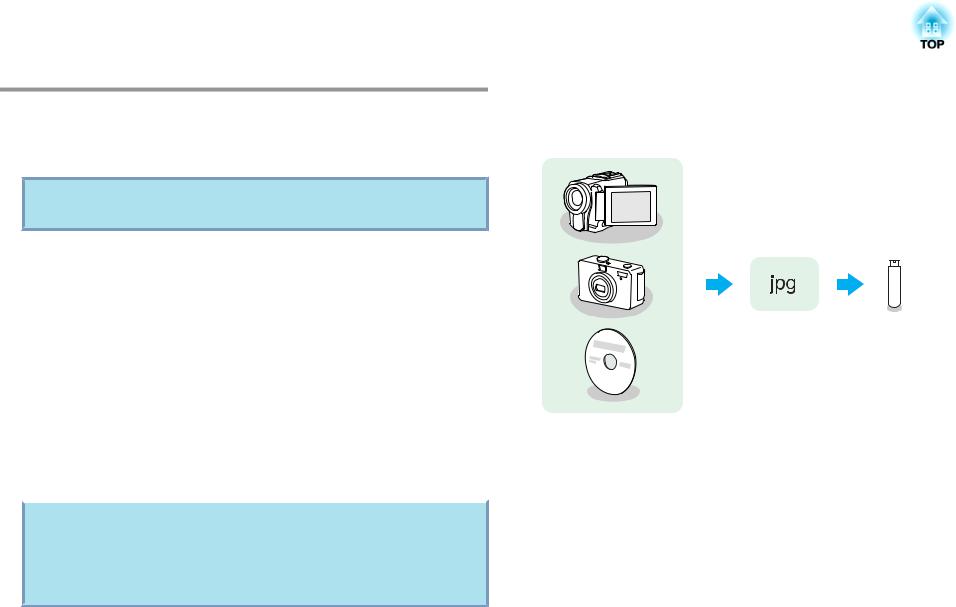
Presentations Using Slideshow |
|
28 |
|
|
|
Files that can be Projected Using Slideshow
You can use Slideshow to directly project files stored in a USB storage device or digital camera connected to the projector.
q You may not be able to use USB storage devices that incorporate security functions.
Specifications for files that can be projected using Slideshow
Type |
|
File Type (Ex |
Notes |
|
|
tension) |
|
Still image |
.jpg |
The following cannot be projected. |
|
|
|
|
- CMYK color mode format |
|
|
|
- Progressive format |
|
|
|
- Images with a resolution greater than 4608x3072 |
|
|
|
- Files with the extension ".jpeg" |
|
|
|
Due to the characteristics of JPEG files, images may |
|
|
|
not be projected clearly if the compression ratio is too |
|
|
|
high. |
|
|
|
|
|
|
||
q |
• When using a USB hard disk, we recommend using an AC adapter |
||
|
power supply. |
|
|
•The projector does not support some file systems, so use media that has been formatted in Windows.
•Format the media in FAT16/32.
Slideshow usage examples
Projecting images stored on USB storage and other media
Example 1: Prepare multiple images and project them continuously (Slideshow)s p.32
Example 2: Select and project image files one at a time s p.31
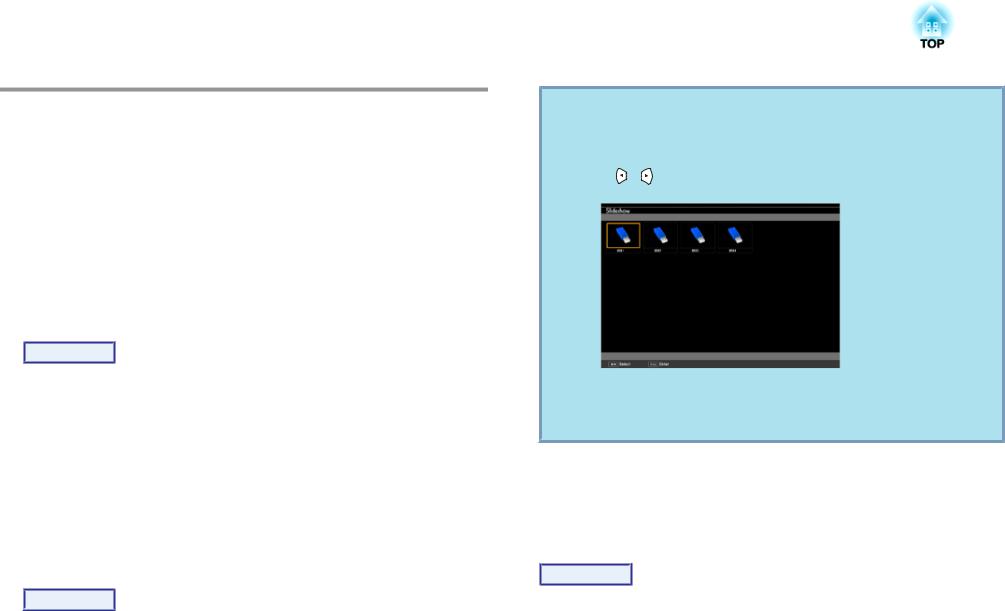
Presentations Using Slideshow |
|
29 |
|
|
|
Slideshow Basic Operations
Slideshow lets you play back and project image files stored on USB storage devices and digital cameras.
This section explains the basic operations for Slideshow.
Although the following steps are explained based on the remote control, you can perform the same operations from the projector's control panel.
Starting and closing Slideshow
Starting Slideshow
Procedure
A Change the projected image to USB.
s p.21
B Connect the USB storage device or digital camera to the projector.
s p.34
Slideshow starts and the file list screen is displayed.
Closing Slideshow
Procedure
To close Slideshow, disconnect the USB device from the USB(TypeA) port on the projector. For a digital camera, hard disk, or other equipment, turn off the power of the equipment and then disconnect the equipment.
q |
• You can also insert a memory card into a USB card reader and then |
|||
connect |
the reader to |
the projector. However, some commercially |
||
|
available card readers |
may not be compatible with the projector. |
||
|
• When the following screen (Select drive screen) is displayed, use the |
|||
|
[ |
][ |
] buttons to select the drive you want to use, and then press |
|
|
the |
[Enter] button. |
|
|
•To display the Select drive screen, position the cursor on Select drive at the top of the file list screen, and then press the [Enter] button.
Slideshow basic operations
The following describes the procedures for playing and projecting images using Slideshow.
Procedure
A Use the [ ][
][ ][
][ ][
][ ] buttons to position the cursor on the target file or folder.
] buttons to position the cursor on the target file or folder.
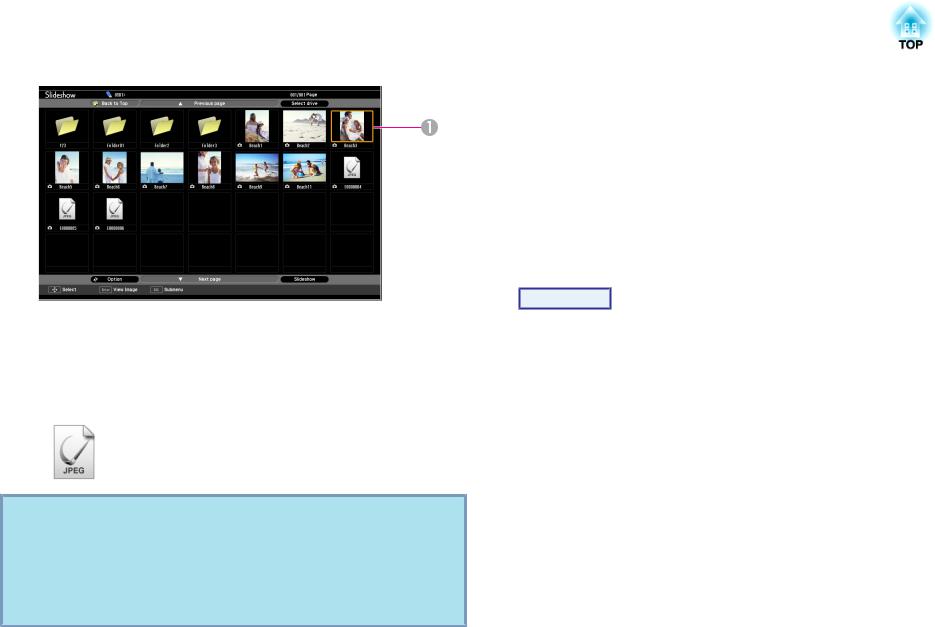
Presentations Using Slideshow |
|
30 |
|
|
|
ACursor
•JPEG files are displayed as thumbnails (file content is displayed as small images).
•Depending on the JPEG file, a thumbnail may not be displayed. In this case, a file icon is displayed.
q If all files and folders cannot be displayed at the same time in the current screen, press the [Page] (Down) button on the remote control or position the cursor on Next page at the bottom of the screen and press the [Enter] button.
To return to the previous screen, press the [Page] (Up) button on the remote control or position the cursor on Previous page at the top of the screen and press the [Enter] button.
B Press the [Enter] button.
The selected image is displayed.
When a folder is selected, the files in the selected folder are displayed. Select Back to Top on the screen that opened and press the [Enter] button to return to the previous screen.
Rotating images
You can rotate the played images in JPEG format in 90˚ increments. You can also rotate JPEG format images during Slideshow.
Rotate JPEG images in the following way.
Procedure
A Play images in JPEG format, or run Slideshow.
To play images in JPEG format s p.31
To run Slideshow s p.32
B When a JPEG image is displayed, press the [ ] button or the [
] button or the [ ] button.
] button.
